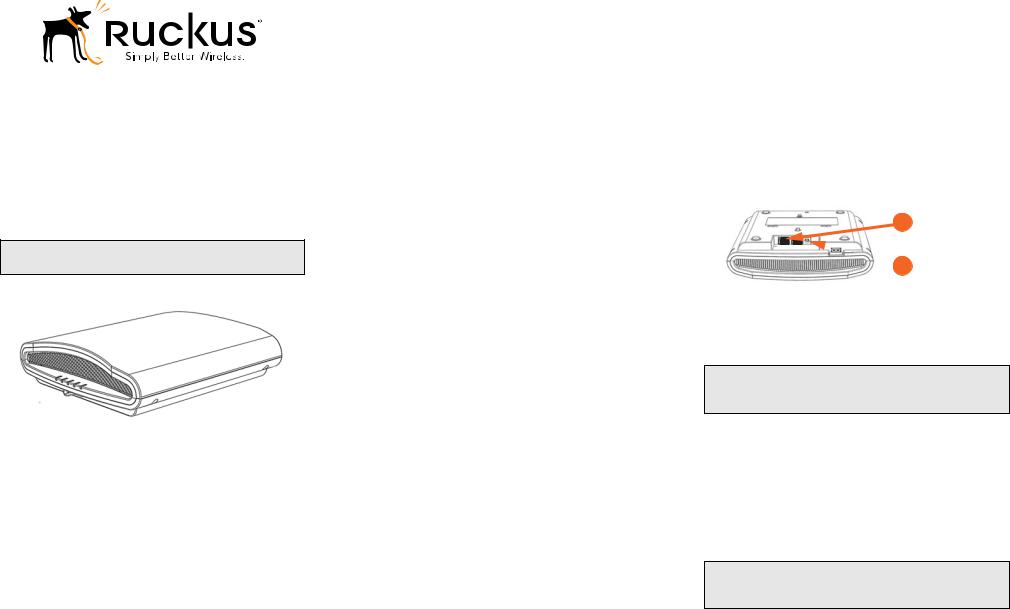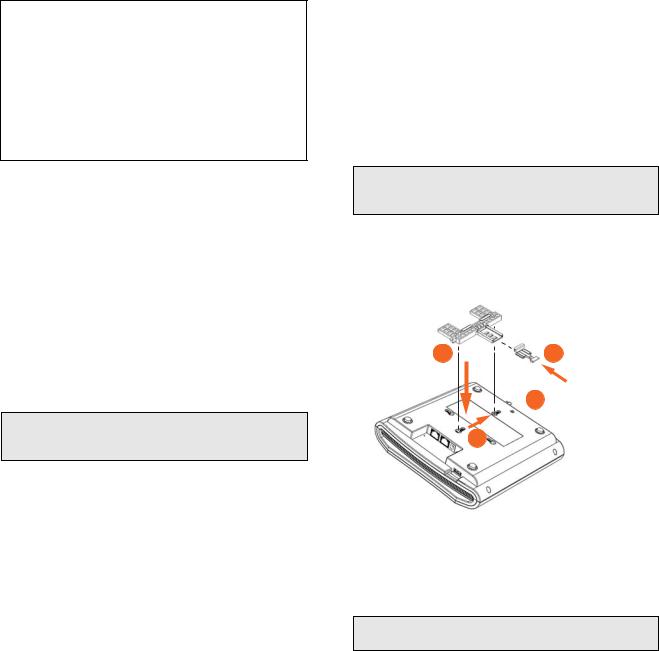Ruckus Wireless R710 User Manual

R710 Access Point
Quick Setup Guide
This Quick Setup Guide provides step-by-step instructions on how to set up your Ruckus Wireless R710 Dual Band 802.11ac Multimedia Wi-Fi Access Point (AP). After completing the steps described in this Guide, you will be able to place the R710 at your site and provide wireless network access to users.
The rest of this document refers to the R710 as the AP.
Note: The minimum software revision for the AP is base image 100.0.2 or later, RuckOS 3.2 or later, or ZoneFlex 9.12 or later.
Figure 1. Ruckus Wireless R710 Access Point
This Guide in Other Languages
https://support.ruckuswireless.com.
Vous trouverez la version française de ce guide à l'adresse suivante https://support.ruckuswireless.com.
https://support.ruckuswireless.com
(https://support.ruckuswireless.com) .
Veja a versão em português (Brasil) deste guia em https://support.ruckuswireless.com.
Puede ver la versión en español (América Latina) de esta guía en https://support.ruckuswireless.com.
Before You Begin
Before deploying Ruckus Wireless products, please check for the latest software and the release documentation.
•User Guides and Release Notes are available at http://support.ruckuswireless.com/documents.
Copyright © 2015 Ruckus Wireless, Inc.
Published 10 February 2015, Part Number 800-70766-001 Rev B
•Software Upgrades are available at http://support.ruckuswireless.com/software.
•Open Source information is available at http://opensource.ruckuswireless.com.
•Software License and Limited Warranty are available at http://support.ruckuswireless.com/warranty.
Package Contents
•R710 Access Point
•One T-bar mounting assembly kit, including:
•One T-bar bracket (2 separate plastic parts)
•Two each 1.0" L x No. 8 steel Phillips panhead mounting screws and plastic wall anchors
•Regulatory flyer
•Product warranty statement
•Declaration of Conformity, if required
•This Quick Setup Guide
CONFIGURING THE AP
Continue with the following steps:
•Step 1: Collecting Setup Requirements, Hardware, and Tools
•Step 2: Connecting Your Computer to the AP
•Step 3: Preparing Your Computer for AP Setup
•Step 4: Logging Into the AP
•Step 5: Customizing the Wireless Settings
•Step 6: Placing the AP in Your Site
•Step 7: Verifying the Installation
Step 1: Collecting Setup Requirements,
Hardware, and Tools
•A computer running Windows 7 (procedures for common operating systems are similar).
•One Cat 5e (or better) Ethernet cable.
•A Ruckus Wireless 902-0169-xx00 AC power adapter (sold separately)
--OR--
an 802.3at-compliant Power over Ethernet (PoE) switch or PoE injector.
Optional hardware and tools:
•Customer-supplied small padlock with a 3.5mm (0.14”) or smaller shackle, used to fasten the AP to the secure mounting bracket or the T-bar bracket.
•Customer-ordered Ruckus Wireless 902-0120-0000 secure mounting bracket kit:
•If you are mounting the AP on a flat surface using the secure mounting bracket kit, then you need an electric drill with 4.75mm (3/16”) drill bits.
•If you are mounting the AP on a pipe or pole using the secure mounting bracket kit, then you will also need a 38.1mm to 63.5mm (1.5" to 2.5") pipe or pole, two
included stainless steel clamps, and hand tools to tighten the clamps.
Continue with Step 2: Connecting Your Computer to the AP.
Step 2: Connecting Your Computer to the AP
1After removing your AP from its package, place it next to your computer.
2Using an Ethernet cable, connect your computer’s network port to the 10/100/1000 POE In port on the AP (A in Figure 2).
3Using an AC adapter (sold separately), connect the AP 12VDC port (B in Figure 2) to a convenient (and protected) power source.
Alternatively, connect the 10/100/1000 POE In port to a PoE injector or switch for both power and network connectivity.
Figure 2. AP ports
A
 B
B
4 Verify that the PWR LED on the AP is a steady green.
Continue with Step 3: Preparing Your Computer for AP Setup.
Step 3: Preparing Your Computer for AP Setup
Note: The following procedures assume that Windows 7 is the operating system. Procedures for other operating systems are similar.
1On your Windows 7 computer, configure your network adapter from the Local Area Connection settings as follows:
•Start > Control Panel > Network and Sharing Center > Change Adapter Settings
2Edit the TCP/IPv4 address settings as follows:
•Local Area Connection > Properties > Internet Protocol Version 4 (TCP/IPv4) > Properties
The Internet Protocol Version 4 (TCP/IPv4) Properties dialog box appears.
Important! Write down all of the currently active settings so you can restore your computer to its current configuration later (when this process is complete).
3Select Use the following IP address (if it is not already selected) and then make the following entries:
•IP address: 192.168.0.22 (or any available address in the 192.168.0.x network, except 192.168.0.1)
•Subnet mask: 255.255.255.0
•Default gateway: 192.168.0.1
Leave the DNS server fields empty.
Page 1 of 4

4 Click OK to save your changes.
Your changes are put into effect immediately. Continue with Step 4: Logging Into the AP.
Step 4: Logging Into the AP
As specified in Step 3: Preparing Your Computer for AP Setup, the computer should be directly connected to your AP through one of the Ethernet ports and powered on, ready for setup.
1On your computer, open a Web browser window.
2In the browser, type this URL to connect to the AP: https://192.168.0.1
3Press <Enter> to initiate the connection. When a security alert dialog box appears, click OK/Yes to proceed.
4When the Ruckus Wireless Admin login page appears, enter the following:
•Username: super
•Password: sp-admin
5Click Login.
Continue with Step 5: Customizing the Wireless Settings.
Step 5: Customizing the Wireless Settings
Default AP Settings (for your reference)
Network Names (SSIDs) |
Wireless1—Wireless8 (2.4GHz |
|
radio) |
|
Wireless9—Wireless16 (5GHz |
|
radio) |
|
|
Security (Encryption method) |
Disabled for each wireless |
|
interface |
|
|
Default Management IP |
192.168.0.1 |
Address |
|
|
|
1On the Web interface menu, click Configuration > Radio 2.4G or Configuration > Radio 5G. The Configure > Wireless > Common page appears.
2Verify that the following options are active:
•Channel: SmartSelect
•Country Code: If you are not located in the United States of America, select your current country.
3Click Update Settings if you made any changes.
4Click any of the “Wireless #” (Wireless LAN Number) tabs at the top of the page.
5In Wireless Availability, click Enabled.
6Delete the text in the SSID field, then type a name for your network that will help your users identify this AP in their wireless network connection application.
7Click Update Settings to save your changes.
Copyright © 2015 Ruckus Wireless, Inc.
Published 10 February 2015, Part Number 800-70766-001 Rev B
8Repeat Step 4 through Step 7 for each Wireless # (Wireless LAN Number) interface that you want to enable.
9Click Logout to exit the Web interface.
Optional: In a default R710 AP configuration, the AP uses a DHCP-assigned IP address.
If you anticipate logging into the AP regularly to perform monitoring or maintenance once it is in place, then you may want to consider switching from DHCP and instead assigning a static IP address to the AP.
A.On the menu, click Configuration > Internet.
B.Click the Static IP option.
C.Fill in the IP Address and Mask fields.
D.Click Update Settings to save your changes.
10When the Ruckus Wireless Admin login page reappears, you can exit your browser.
11Disconnect the AP from the computer and from the power source, and then restore your computer to its original network connection configuration.
Continue with Step 6: Placing the AP in Your Site.
Step 6: Placing the AP in Your Site
1Move the AP to its permanent location (accessible to both power and network connections). Refer to Mounting Instructions for physical installation.
2Use an Ethernet cable to connect the 10/100/1000 port to the appropriate device:
•The ISP’s or carrier’s network device --or--
•The Ethernet switch that is connected to the ISP’s or carrier’s network device.
Note: If you will be using PoE, then you will need a Cat 5e (or better) Ethernet cable to connect the AP to the PoE injector or PoE switch.
3Connect the AP power adapter (or PoE power supply) to the AP, and then to a convenient power source.
4Verify that the 10/100/1000 port LED is lit.
After a short pause to re-establish the Internet connection, you can test the AP. Continue with Step 7: Verifying the Installation.
Step 7: Verifying the Installation
1Using any wireless-enabled computer or mobile device, search for and select the wireless network you previously configured.
2If you can connect, open a browser and link to any public Web site.
Congratulations! Your wireless network is active and ready for use.
MOUNTING INSTRUCTIONS
The AP can be mounted to a drop-ceiling T-bar, flat surface, or a pole using Ruckus Wireless AP mounting kits. Refer to the following sections:
•Mounting on a Drop-Ceiling T-Bar
•Mounting on a Flat Surface
•Mounting on a Flat Surface or Pole Using the Optional Secure Mounting Bracket
Mounting on a Drop-Ceiling T-Bar
The factory-supplied T-bar mounting assembly kit allows you to attach the AP to recessed and flush drop-ceiling T-bars.
1Position the studs on the bottom of the T-bar bracket (A in Figure 3) in the keyholes on the AP enclosure.
Note: There is a second set of keyholes that are for optional sideways mounting on a drop-ceiling T-bar. Physical security is not supported when mounting the AP with this set of keyholes.
2Slide the T-bar bracket away from the Ethernet ports on the bottom of the AP until the AP retainer tab (B in Figure 3) snaps into place, trapping the T-bar bracket studs in the keyholes (C in Figure 3).
Figure 3. Attaching the T-bar bracket to the AP
A |
D |
 B
B
C
3Insert the locking tab (D in Figure 3) so it is in the first position on the T-bar bracket (A in Figure 3).
4Gently push the ceiling tiles, if present, up and out of the way.
5Position the T-bar bracket so its two clasps grip one edge of the T-bar (A in Figure 4). Make sure that both clasps are gripping the T-bar.
Note: For clarity, Figure 4 only shows the T-bar bracket and the T-bar, and does not show the AP.
Page 2 of 4
